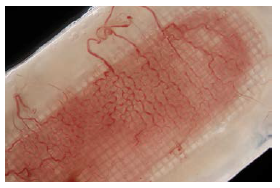Transforming Diabetes Treatment
Paul Laikind, Ph.D., President and CEO of ViaCyte, talks about the company’s research on a stem-cell derived therapy for diabetes.
 About 29.1 million people — about 1 out of every 11 people — have diabetes. About 5%, or about 1.25 million people, have type 1 diabetes, where the body does not make enough insulin. These patients must have insulin delivered by injection or a pump to survive. People who have diabetes are at a high risk of serious health complications, including blindness, kidney failure, heart disease, stroke, and loss of toes, feet, or legs.
About 29.1 million people — about 1 out of every 11 people — have diabetes. About 5%, or about 1.25 million people, have type 1 diabetes, where the body does not make enough insulin. These patients must have insulin delivered by injection or a pump to survive. People who have diabetes are at a high risk of serious health complications, including blindness, kidney failure, heart disease, stroke, and loss of toes, feet, or legs.
In 2012, the estimated costs — both direct and indirect — for all types of diabetes in the United States were $245 billion. Direct medical costs were $176 billion and the average medical expenditures among people diagnosed with diabetes were 2.3 times higher than people without diabetes. Indirect costs — including disability, work loss, and premature death — were $69 billion.
The emerging field of regenerative medicine is providing a new leap forward in diabetes treatment research. One company making strides in this area is ViaCyte, which is developing a cell replacement therapy designed to provide the insulin producing cells lost to the disease in order to eliminate the need for glucose monitoring and insulin injections.
ViaCyte is working on a first-in-class stem cell-derived islet replacement therapy for the treatment of type 1 diabetes. By acting essentially as a replacement endocrine pancreas, the source of insulin and other regulatory hormones produced in the body, ViaCyte’s VC-01 product candidate has the potential to be a functional cure for type 1 diabetes.
“We isolated a single embryonic stem cell line about 10 years ago, and that single cell line gives all the cells we need to treat virtually all diabetes patients," says Paul Laikind, Ph.D., president and CEO of ViaCyte. “Stem cells are pluripotent cells capable of propagating themselves indefinitely providing an unlimited supply of starting material for VC-01. We have done a lot of work to develop technologies that allow us to take that stem cell through a process of directed differentiation to create pancreatic progenitor cells."
These pancreatic progenitor cells are expected to go on to become the cells of an islet. The islet is a collection of cells in the pancreas, including the beta cells, the alpha cells, delta cells, which produce regulatory hormones including insulin, glucagon, and somatostatin.
 “The PEC-01 cells are designed by nature, if you will, to exist in a hypoxic environment to recruit the vascularization and to essentially grow an organ," Dr. Laikind says.
“The PEC-01 cells are designed by nature, if you will, to exist in a hypoxic environment to recruit the vascularization and to essentially grow an organ," Dr. Laikind says.
The human pancreatic progenitor cells are then contained in a semi-permeable encapsulation device, called the Encaptra drug delivery system. The Encaptra system is designed to deliver the cells to the patient and protect them from attack by the patient’s immune system.
“The Encaptra drug delivery device is like a teabag; it has a semi-permeable membrane that allows the free flow of oxygen and nutrients, including proteins such as insulin and glucagon, to move back and forth across the net membrane, but what it doesn’t allow is any cells to move back and forth," Dr. Laikind explains.
Dr. Laikind says the encapsulation process is designed to prevent cell–cell interaction between the cells that are implanted and blocks the adaptive immune system, which produces antibodies and various other ways to reject foreign bodies.
The cells VC-01 product candidate, which is about the size of half of a business card, is implanted under the skin. Animal models show that over several months, the cells mature and differentiate. They continue to proliferate and fill the device and begin producing insulin and glucagon.
“This process continues as long as the product is well-vascularized so that the cells in the device can sense the blood glucose levels and then appropriately release the factors such as insulin and glucagon into the blood stream," Dr. Laikind says.
This cell replacement therapy is currently being evaluated in a Phase I/II clinical trial in patients who have minimal to no insulin-producing beta cell function.
“In addition to putting in what we call the dose-ranging units — the dose-ranging Encaptra devices containing cells — we’re also putting in sentinels," Dr. Laikind says.
“The sentinels are smaller device-cell combinations that are implanted at various locations to assess various conditions. We are implanting up to six sentinels in each patient. We will withdraw them periodically, for instance, at one week, four weeks and/or 12 weeks, and conduct histology tests. We want to evaluate whether vascularization is occurring, how healthy the cells are, and most importantly of course, whether the cells are differentiating and becoming insulin-producing cells."
In the company’s Phase I trial, 12 patients have been implanted so far and the VC-01 product candidate appears to be safe and well tolerated. There also has been no evidence of any off-target growth, which is often a concern of stem cell-derived products.
The current trial is broken into two groups. In Cohort 1, patients receive a sub-therapeutic dose of cells in VC-01 product candidate and up to six sentinels. ViaCyte will make changes to the procedures based on the findings of the sentinel results to improve the trial. Once company researchers demonstrate that they have maximized the potential of the implant, they plan to begin Cohort 2.
From a regulatory standpoint, the product is being reviewed as a biologic through the Center for Biologics Evaluation and Research, with consultation from the Center for Devices and Radiological Health.
ViaCyte is a venture-capital financed company and has received funding from the JDRF, which has provided almost $14 million toward ViaCyte’s research. The company has also received substantial funding from the California Institute for Regenerative Medicine.
In February 2016, ViaCyte and Janssen Biotech agreed to consolidate the assets of the Janssen BetaLogics group into ViaCyte. The agreement provides ViaCyte with an exclusive license to all BetaLogics intellectual property in the field of metabolic disease, including diabetes. The companies had been working independently toward a stem cell-derived therapy for diabetes. (PV)



















